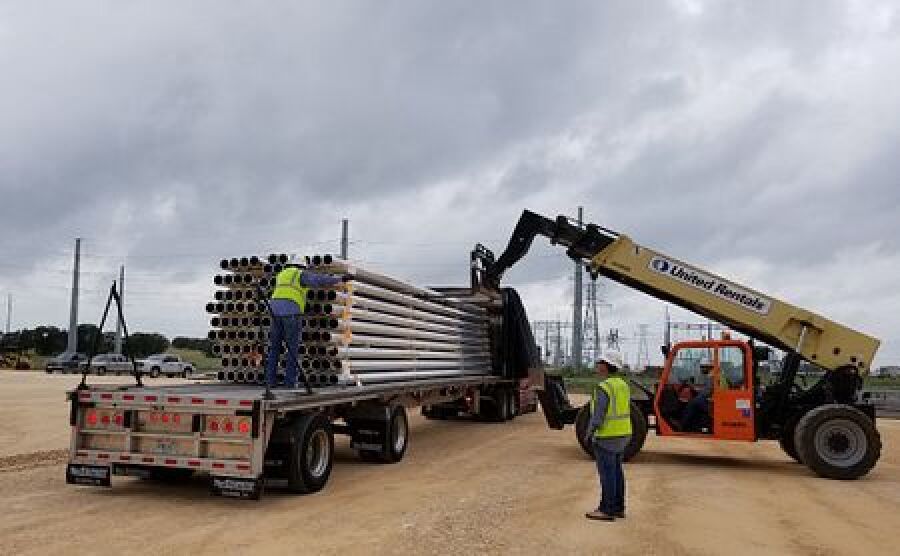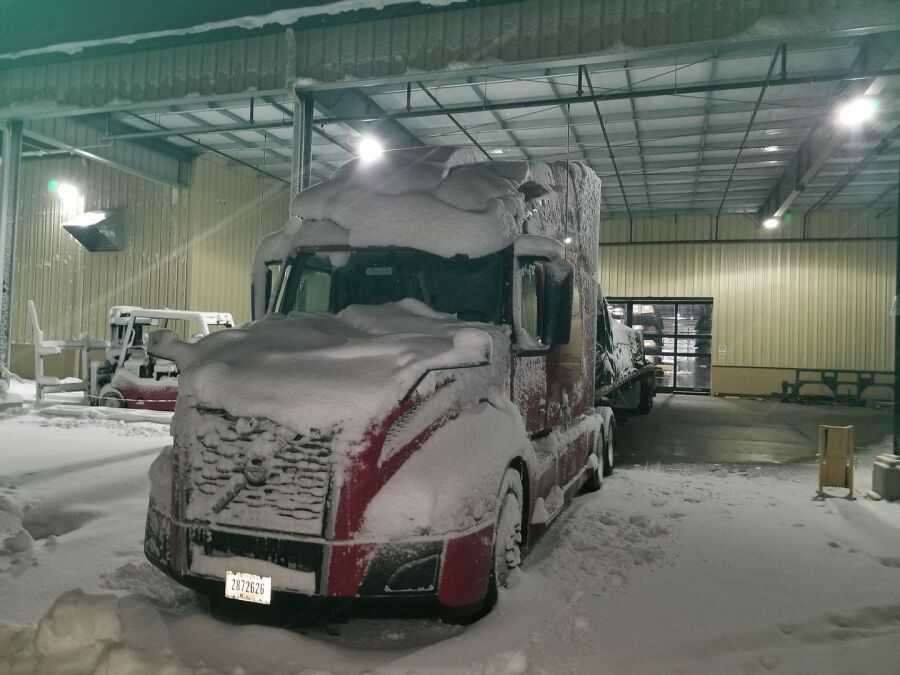Question About Flatbed Loads/Unloads
Topic 30770 | Page 1
Matt, you are correct in your assumption. Most of the time flatbeds get loaded and unloaded from the side. Part of the purpose of the flatbed trailer is to haul unconventional, or what flatbedders call "open deck," freight. It is really difficult to load or unload 48' steel beams with a dry-van trailer. We typically unload from the side. Because of that we seldom ever use a traditional dock that we back up to. I've occasionally had to back into a loading dock, but it is uncommon. Here's a photo of a typical flatbed load being unloaded.

That photo is also a "construction site" for an electrical power distribution plant. So that may answer your question about construction sites and unique locations. I have picked up loads and delivered to places like this often. We sometimes load at mining sites or oilfield facilities. There is an endless variety of flatbed work. You can see a lot of different flatbed loads in this conversation about Flatbed Variety.
Sometimes we pick up our loads at really large manufacturing facilities where we actually drive inside the buildings and are loaded with overhead cranes. Here's a picture of that type scenario.

That yellow equipment at the top of the photo is an overhead crane. It can move from one end of the building to the other. It is a common way to load or unload a flatbed trailer at large facilities designed to accommodate indoor traffic.
Sometimes we may be out in the open when we unload which tells you that we deal with the weather at times. Other times we may have somewhere we can back up under a covered area like a large shed. Here's a shot of my truck backed up under an extended roof of a large metal building. This is a designated area where we unload at this customer in Connecticut.

Doing drop and hook loads are not that common in flatbed work. I actually do a lot of drop and hook loads but it is because I am on a dedicated account where my customer that I am dedicated to has plants all over the United States. I seldom have to wait to get loaded unless it is a third party back-haul load, which is not real common in my situation. It happens, but not that often for me. Most flatbed jobs do not do many drop and hooks. They happen sometimes with materials like sheetrock from the manufacturer's facility, but for the most part we do live loads and unloads. We don't have very long wait times with our loads though, so that is an added benefit of the flatbed work.
Drop And Hook:
Drop and hook means the driver will drop one trailer and hook to another one.
In order to speed up the pickup and delivery process a driver may be instructed to drop their empty trailer and hook to one that is already loaded, or drop their loaded trailer and hook to one that is already empty. That way the driver will not have to wait for a trailer to be loaded or unloaded.
Thank you, Old School, for your detailed response and the photos. That really helps me get a better sense of the work, the loads, the locations. I'll look further through the other thread you linked, which I've looked at a bit before, but that had got me wondering about the methods of loading/unloading and the types of facilities, which you just nicely answered.
As a middle-aged career changer, the variety is definitely intriguing to me, getting to see a variety of places and dealing with different types of loads. In my current work, I'm always the one talking to the construction contractors we hire, finding out more about their work, and glad when we have to take the bookmobile to some unusual place for service. On a recent roadtrip through South Dakota, Wyoming, and Idaho, I was intrigued by all the semis I saw hauling haybales and other flatbed loads through remote agricultural areas.
Anyway, your descriptions above give me a better sense. I hadn't thought about the indoor plants with overhead cranes. You got a bit of snow when you were unloading at that shed in Connecticut, eh? 
"Mama always said, flatbedding is like a box of chocolates: you never know what you're going to get."
At Prime, we really get a lot of variety. I recently posted the in the flatbed variety forum a picture of the irrigation system I delivered to a field in Florida. Even when you are going to a specific shipper where you've been before, you may not know that you're going to get until its on the trailer. I recently picked up an aluminum ingot from Bluffton, Indiana. It was one solid block of aluminum about 12 feet long, 4 feet wide and 2 feet high. It was an easy securement and tarp job. But other drivers had smaller palletized product. Same thing at the other end at the unload in Oswego, New York. Pull off my tarp and straps and 5 minutes to unload. Easy.
One of Prime's main customers ships PVC and metal pipe. These are kind "drop and hook" as it's a preloaded trailer and self serve BOLs. You find the paperwork in the vacant office, find your trailer, hook up, secure and go.
Another "drop and hook" that we haul are building materials. Sometimes this delivers at a construction site. Sometimes, you deliver to a residence. The customer orders a building and the preloaded trailer you pick up contains the entire building. These are more challenging to secure because it's a hodge podge of stuff. They actually don't "load the trailer." They stack all of the building materials on dunnage and then back trailer under the entire load and lower it down. These are very slow unloads because you have to unload it one piece at a time. I delivered one of these to a remote property in Banning, California where had to drive a significant distance down a dirt road. I was on the phone with the guy as I turned off the paved road and the first thing I noticed was the bridge was out. "Oh yeah, you have to drive through the creek bed."
When I hauled Tracker boats, one delivery required you to back under a lift. That wasn't the problem, per se. It was the fact that you had to be coming from the other direction to back under the lift. The road was a two-lane road, no shoulders. To turn around, you had to drive a mile up the road, pull into a narrow gravel road, and then blind-side back onto the two-lane road to get turned around.
I've delivered to Brooklyn, where the business didn't have enough space on their property for the pipe, so they just stacked it on the street. I've delivered to Staten, Island, where you need every inch of street and some of the sidewalk to turn corners.
But a lot of places where we deliver have big yards where you just pull somewhere in the middle so they can get on both sides.
But then we also back into places that makes bumping a dock seem easy. See the picture below. So, I strongly disagree with someone who says flatbedders can't back.

Shipper:
The customer who is shipping the freight. This is where the driver will pick up a load and then deliver it to the receiver or consignee.
Drop And Hook:
Drop and hook means the driver will drop one trailer and hook to another one.
In order to speed up the pickup and delivery process a driver may be instructed to drop their empty trailer and hook to one that is already loaded, or drop their loaded trailer and hook to one that is already empty. That way the driver will not have to wait for a trailer to be loaded or unloaded.
Chief Brody,
Fascinating to hear your stories and descriptions, and doubly so since I'm strongly considering Prime. I'm getting a better sense of the variety, from the relatively straightforward to the complex and complicated. When I looked at your pic above, at first I just thought it was all the inside floor of an industrial plant... until I saw the bed of your trailer and was like, "Oh..." Lol. Driving through the creek bed sounds like an adventure... cutting sidewalks in Brooklyn a little less fun. But so it goes, I imagine.
Do you tend to get a detailed description of the load beforehand, is it more of a vague idea, or is it a surprise when you show up at the shipper (other than knowing what kind of shipper they are)?
Shipper:
The customer who is shipping the freight. This is where the driver will pick up a load and then deliver it to the receiver or consignee.
OWI:
Operating While Intoxicated
The most that you'll get as far as the information on the load is the weight. But even at the same shipper different trucks will get different loads.
There's a shipper in Calvert, Alabama that I've picked up a couple times before and all of the other trucks we're getting coils and then plates of steel that had edge protection on them. But when my steel plates came out none of it had a protection on it. And I had expected to get two bundles of steel plates one in the front one in the back. So I had the forklift operator put my coil in the middle. But I ended up getting one bundle of steel plates. I had asked the forklift operator to move my coils so that I could put the one bundle of steel plates on the deck together but he refused. He ended up separating it so I had to use two tarps and lots of edge protection.
But then other places like shinges are always the same.
Shipper:
The customer who is shipping the freight. This is where the driver will pick up a load and then deliver it to the receiver or consignee.
New Reply:
New! Check out our help videos for a better understanding of our forum features

















Preview:








 TT On Facebook
TT On Facebook
So, a "dumb" question, out of curiosity: For flatbedders, is the loading and unloading typically done somewhere else besides a standard loading dock? I'm thinking of some of the type of loads--aluminum, lumber, etc.--and those perhaps seem odd to go through a loading dock. Or are they typically drop-and-hook (there's probably not a "typical")? How often are you delivering directly to construction sites or unique locations?
I know this is a generalizing question, so thanks for any perspective. I'm just trying to get a better sense for it.
Drop-and-hook:
Drop and hook means the driver will drop one trailer and hook to another one.
In order to speed up the pickup and delivery process a driver may be instructed to drop their empty trailer and hook to one that is already loaded, or drop their loaded trailer and hook to one that is already empty. That way the driver will not have to wait for a trailer to be loaded or unloaded.
HOS:
Hours Of Service
HOS refers to the logbook hours of service regulations.